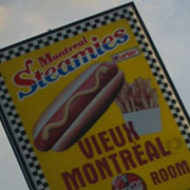Party: First, a brief comment on last night’s departmental Christmas party. Usually, the phrase “departmental Christmas party” sounds like “office Christmas party” which is a particularly reviled genre of party. But this year, it was organized by the sparkling new Graduate Student Association and involved the rental of the basement of the Graduate Student Union, a sound system, some tasty DJing, a pile of food and a bar. Outstanding! The department that parties together, er, enjoys filing paperwork together? I don’t know what the proper adage is, but the event was really great.
Theory: A week or so back Ted Striphas had a post about approaches to Deleuze and Guattari in scholarly work, and it seems to me that he touched on some issues relevant to the use of “theory” more generally in the humanities. He posits a hierarchy of uses:
(1) What I like to call, “rhizome spotting.” Here, the analyst tries to find evidence of Deleuzoguattarian concepts at work in the world.
(2) Applications. In this case, the analyst takes up one or more Deleuzoguattarian concepts and “applies” them to an empirical object.
(3) Operationalizing/extending Deleuze & Guattari’s work. A lot of interesting work operates at this level. Here, the analyst engages the work of Deleuze and Guattari and makes their work resonate with one or more empirical objects. Often this results in some kind of extension or elaboration of Deleuzoguattarian thought.
(4) Reading what Deleuze and Guattari have read and extending their work therefrom. My sense is that Brian Massumi and Greg Seigworth tend to engage in this kind of practice, as in, for example, where Seigworth reads Freud’s early texts for evidence of the ways in which he sublimated affect.
(5) Implicit dialogue. I’m most tentative about this category, but I’ve long felt that people like Giorgio Agamben and Jean-Luc Nancy take up Deleuzoguattarian ideas without mentioning D+G’s work explicitly. For example, both Agamben’s “The Coming Community” and Nancy’s “The Inoperative Community” seem to be responses of sorts to the Deleuzoguattarian insight, “the people are missing.”
Now, I’ve often said the same thing: pattern recognition isn’t theorizing. “Look! Over there! A Panopticon!” doesn’t really explain anything. I really tried to push students in my seminar past the “application” phase of theory reading as well. I think I may have made them a little crazy in the process, since it’s a tall task for one term. And it’s not like I’m even at the ideal level most of the time. Still, you set your goals so when you miss it’s still good, right? So the goal, if you like theory, is to read it as inspirational literature, that helps to explain the world in new ways. Even “implicit dialogue” isn’t necessarily theory. There is another genre of scholarship, which my teacher John Lie calls “commentary” that best describes the vast amount of North American work on “theory” today: commentary is when the author comments on the work of a theorist. Now, some like Derrida or Deleuze acutally elevate it to fashioning new ideas, but only because they do some mangling to the work of the people upon whom they comment. The theorists I like, anyway, aren’t devoted to one person or one school, but draw in and mix up lots of influences.
So what are the best uses of theory for me? They are two, really. One is where the theory is an inspiration for redescribing something in the world. With the exception of Derrida, the “theorists” I like best all are at their best when they describe something we thought we understood in a new and profound way. In other words, the best theory for me is “about” something other than theory. It’s about the world. The other great use of theory is like scales for music. One learns particular cadences, directions and movements. It’s exercise for the mind, learning to think in new ways. But just as perfect performance of a scale is good for a lesson but not a performance, a perfect explication of a theorist is good for the seminar but not for the conference or the publication. In both cases, the goal is to use the tools you have to make music.
But there’s a catch. Those “lesser” steps — spotting and application — actually do have their place in the grand scheme of scholarship. When Paul Gilroy uses “rhizomatic” to talk about black atlantic identity, or Judith Butler configures her “matrix of gender” to work an awful lot like Derrida’s differance, they’re doing a bit of “spotting” but for them it is only one step in a process, just as a melody may have a piece of a scale in it.
Okay, enough with the music metaphors for now, though in fact one of my bass teachers, Craig Anderson, who taught me how to improvise, also inadvertantly taught me a great deal about how to think. That’s another post, though. For all I know, I might have already blogged about that.
—
On another theoretical note, Steve Fuller has been testifying on behalf of Intelligent Design people. Now, I know Fuller’s work and I’ve met Fuller and he’s a smart guy and his argument about taking science of its epistemological pedastal is an important one. But I question his political judgment. I mean, I’m all for public debate and all, but teaching creationism in schools does not strike me as a better alternative than teaching science in biology classrooms. Let me put it another way. His critique of science is less important than maintaining the separation of church and public educaiton in the United States. Ergo, he should not be testifying on behalf of creationsists. Learn more here and here.
Okay, onto that essay now.

